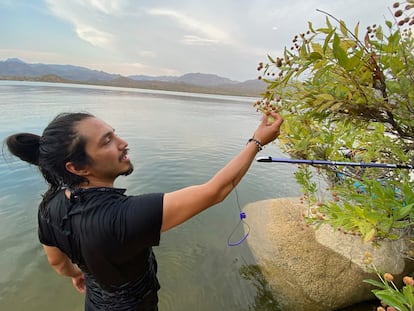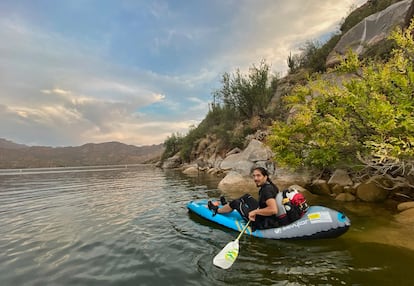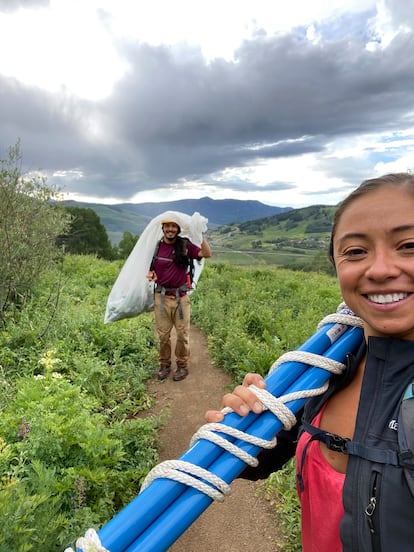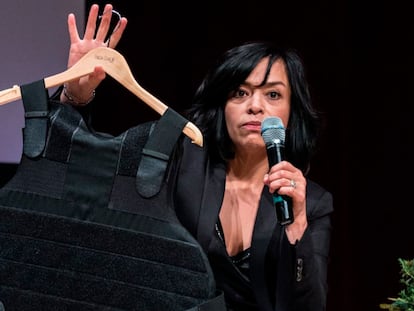Gabriel Trujillo, the US botanist murdered in Mexico while doing field research
The Berkeley student was shot dead in the town of Yécora, while studying plants for his doctorate thesis

The common buttonbush, also known as guayabillo, is a toxic plant with multiple medicinal uses. Native to eastern and southern North America, it grows in temperate climates and in different habitats in Mexico. One of these habitats is the forests of the Mexican state of Sonora, where Gabriel Trujillo was found dead on June 21.
The 31-year-old American botanist, with Mexican roots, was a PhD student at the University of Berkeley and had come to the region to carry out field work as part of his research on this plant. But, a few days after settling in Soyopa, a Mexican town near the Yaqui River surrounded by natural landscape, his body was discovered with several gunshot wounds.
After his family reported him missing, the scientist was found by agents of the State Public Security Police (Pesp) in a ravine a few meters from the edge of the stretch of road that leads from the town of San Nicolás to Tepoca, Yécora, Sonora Prosecutor’s Office stated in a statement on June 30 — nine days after Trujillo was reported missing.
The botanist was in Mexico to advance his doctoral research. Although authorities have not discussed the possible causes of the murder, the autopsy carried out revealed that Trujillo died from several gunshot wounds. The leading hypothesis is that the homicide was related to narco violence. Yécora has become a war zone for organized crime and is one of the Mexican towns most affected by the turf wars between the different cartels in the region. Its geographic location — on the border of the state of Arizona and within “The Golden Triangle” (a region made up of overlapping parts of the states of Sinaloa, Durango and Chihuahua) — has made it a strategic point for drug trafficking to the United States. Sonora is also one of the most dangerous states in Mexico for environmental defenders.

Trujillo — who had been traveling around Mexico for four years as part of his doctoral thesis — had come to the town of Yécora to collect specimens of the common buttonbush a highly resilient species that could provide insight on how to restore ecosystems.
The student’s line of research focused on analyzing the factors that could trigger tropical woody plants to adapt to temperate clients. He was focusing specifically on species of the Cephalanthus genera, such as the common buttonbush, which he was trying to collect when he was murdered.
This group of woody angiosperms is found from boreal zones to tropical zones. Trujillo was trying to understand the mechanisms that had allowed this climatic adaptation. In order to expand to colder habitats, some tropical specimens develop strategies to adapt physiologically, morphologically and genetically to new territories. Trujillo was focusing his research on the mechanisms through which certain frost-tolerant plants lose or gain functional traits, and how these attributes help them expand from their tropical origins to temperate zones. An example of this type of adaptation is the development of tissues with a higher sugar content that allow these plants to tolerate freezing or the production of protective chemical compounds that help prevent the formation of ice crystals, and resulting cell damage.
In search of indigenous heritage
On his trip to Mexico, the botanist also sought to reconnect with his indigenous Opata heritage, an ethnic group that lives in the mountains of Sonora and Chihuahua. Trujillo was a U.S. citizen, but felt strongly connected to the country of his family. His fiancé Roxy Cruz-de Hoyos was a fellow botanist who also had family roots in Mexico. When he stopped answering her phone calls, she traveled to Mexico to look for him.
In an obituary posted by Cruz-de Hoyos on social media, Trujillo was described as a man with “a passion for nature and culture and a relentless drive for science.” “He found solace in the beauty of nature, always eager to learn and protect the environment he held so dear,” it said.

Authorities in Mexico and the United States are working together to find out who murdered Trujillo. Meanwhile, his family and friends have started a fundraiser on GoFundMe to raise money to cover the high cost of repatriating his body.
Although there are no signs yet of any link between Trujillo’s environmental activism and his murder, Mexico is a dangerous place for environmental defenders. In 2022, it was the Latin American country with the highest number of activists murdered. Protecting natural resources and biodiversity often costs defenders their life. The murderers are rarely determined, much less brought to justice.
Sign up for our weekly newsletter to get more English-language news coverage from EL PAÍS USA Edition
Tu suscripción se está usando en otro dispositivo
¿Quieres añadir otro usuario a tu suscripción?
Si continúas leyendo en este dispositivo, no se podrá leer en el otro.
FlechaTu suscripción se está usando en otro dispositivo y solo puedes acceder a EL PAÍS desde un dispositivo a la vez.
Si quieres compartir tu cuenta, cambia tu suscripción a la modalidad Premium, así podrás añadir otro usuario. Cada uno accederá con su propia cuenta de email, lo que os permitirá personalizar vuestra experiencia en EL PAÍS.
¿Tienes una suscripción de empresa? Accede aquí para contratar más cuentas.
En el caso de no saber quién está usando tu cuenta, te recomendamos cambiar tu contraseña aquí.
Si decides continuar compartiendo tu cuenta, este mensaje se mostrará en tu dispositivo y en el de la otra persona que está usando tu cuenta de forma indefinida, afectando a tu experiencia de lectura. Puedes consultar aquí los términos y condiciones de la suscripción digital.
More information
Archived In
Últimas noticias
Tiger Woods turns 50: Will he continue playing on the PGA Tour or take a back seat?
The surreal journey of James Nnaji, the Barcelona youth player selected in the NBA Draft who ended up in the NCAA
Trump claims peace in Ukraine is near, but Moscow suggests otherwise
A survivor’s account of the Interoceanic Train accident: ‘We were scared because of the speed on the curve’
Most viewed
- Oona Chaplin: ‘I told James Cameron that I was living in a treehouse and starting a permaculture project with a friend’
- Reinhard Genzel, Nobel laureate in physics: ‘One-minute videos will never give you the truth’
- Why the price of coffee has skyrocketed: from Brazilian plantations to specialty coffee houses
- Pablo Escobar’s hippos: A serious environmental problem, 40 years on
- Chevy Chase, the beloved comedian who was a monster off camera: ‘Not everyone hated him, just the people who’ve worked with him’










































